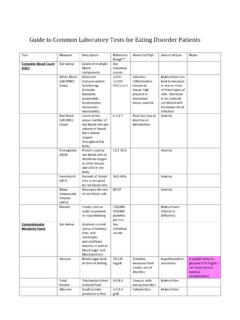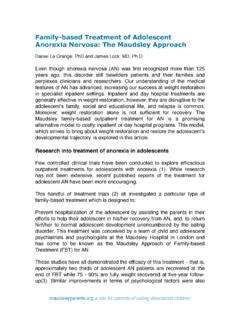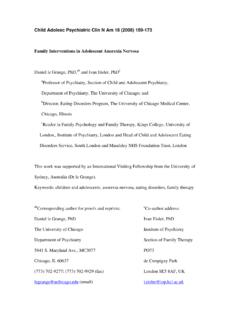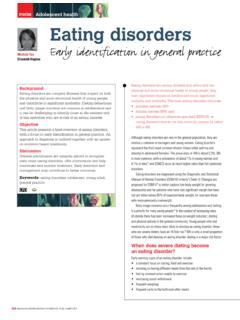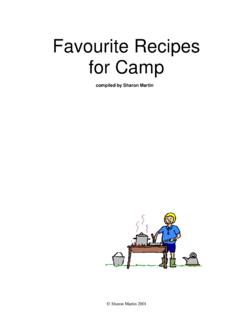Transcription of Now What? - Maudsley Parents
1 You ve been told to go home and feed your child now what ? Parents using the Maudsley approach to help their children recover from anorexia have to come up with menus that have enough calories to reverse the process of malnutrition. It s a daunting task, and it usually requires a paradigm shift. Most of us have been taught from early on to cut calories, not add them. We ve been told to look for ways to cut back on fat, not add it in. But your child needs lots of calories and a balance of protein, fats and carbohydrates. Most people are surprised to learn just how many calories it takes to reverse the malnutrition of anorexia. (Some doctors are surprised about this, too.) While no one can explain exactly why this is true, the answer probably has to do with how the metabolism is altered by malnutrition. Every child will gain weight at a different rate.
2 Most families find the right level to support weight gain with a little trial and error. Your Maudsley therapist will help your family get on the same page, brainstorm solutions, and stay focused on restoring health. The tough job of translating that help into action at home falls to you. Since no two families eat in the same way, the recipes and feeding suggestions are meant to help you come up with menus that work for you. If you ve got a recipe you d like to share, please email it to us at Thanks to Craig, Ann E, Sarah, Ann F, Susan and Jane for parent-to-parent advice. Tips One of the challenges of the re-feeding process is the fact that nearly all those in recovery from anorexia experience some uncomfortable fullness and stomachaches. During starvation, the metabolism and digestive processes slow way down, and they must readjust when the child begins to eat again.
3 Some people find that a warm heating pad over the stomach helps during and after meals. To cut down on stomachaches, as well as on the anxiety and fear of eating, many families try to fit their child s calorie requirements into the smallest possible footprint. This accomplishes several things: It s efficient, it reduces the volume of food your child must eat, and it inevitably consists of high-quality, high-fat foods. Many families think about meal planning in terms of getting the most bang for their nutritional buck--bang meaning not just nutrients but also calories. In other words, if you re choosing between an ice cream with 140 calories per half cup and one with 270 calories per half cup, keep in mind that your child will have to eat less of the higher-calorie version. Early in recovery, that s usually a good thing. You ll probably want to plan meals around foods your child used to like.
4 I knew that food was my daughter s medicine. It took me somewhat longer to grasp the reality that it was going to take an enormous number of calories to begin to heal her. I wasn t emotionally strong enough to push calorie levels high enough as quickly as most advised, so I kept questioning my ability to help her because I felt like I wasn t doing things the right' way. I finally came to realize that just because we needed to do things differently, it didn t mean it was wrong. It just meant that we found what worked for our family. a site for Parents of eating disordered children We do not recommend Parents lie or sneak ingredients into foods. That said, discussions of specific food ingredients or calorie counts can be very anxiety provoking for kids. Sometimes Parents stick to general answers (like It contains the nutrients your body needs or It has everything we know you need to get well ) to avoid being drawn into unproductive conversations.
5 You can boost the caloric value of your favorite foods by adding butter, cream, whole-fat milk, olive oil, whipped cream, etc. as appropriate. Some families also cut back on servings of plain fruits and vegetables during re-feeding, because these foods add fiber, take up a lot of room in the stomach (which can lead to feeling too full), and just don t add many calories--unless, of course, they re served in cream sauces or with whipped cream. Instead of serving plain fruit consider baking a pie, cobbler or crisp. Try french fries instead of boiled potatoes. Vegetables coated in olive oil and roasted make a nice dish and bump up the calorie level. When we began treatment my daughter had an appointment with the adolescent medicine specialist. We walked out with a piece of paper with her medical diagnosis on it malnutrition and amenorrhea secondary to anorexia nervosa.
6 Of course I knew before hearing that she needed to eat, but somehow it really brought home that I had a starving child and we needed to tackle this head on. When families begin family-based treatment for anorexia it can mean doing things very differently than has been typical for them in the past. Often family members have not dined together for every meal, for example. There s no getting around Parents simply being there as an important first step. This can be a real challenge for Parents and may involve changing routines, juggling work schedules or arranging leave to be available for each snack and mealtime. I made an appointment to speak with the principal about how the school could help. Going in with a positive attitude and some specific ideas worked out well. Her teachers and the school staff had noticed she seemed ill and miserable.
7 They were worried about her and, once we explained the situation, were glad to help. She missed some school until we d established a good eating routine and then attended school for half days for a while. Her teachers arranged for her make up missed work she at home. Over the next few months I brought lunch and ate with her in a small private room at school. It was a tough time for our family but their support really helped us put first things first. Here are some getting started tips from experienced Parents : Plan for a parent to eat every meal and snack with the child. It can be difficult to arrange, but being consistent pays off. Teens who are acutely ill may not be able to manage lunch at school or snacks on their own. Grocery shop without your child if possible to avoid negotiating with the eating disorder. Choosing food can be anxiety-provoking for someone with anorexia.
8 Keep your child occupied and out of the kitchen while you re cooking if possible, to reduce her anxiety and avoid negotiations about what and how much to serve. Use positive distractions when you can. Some families read aloud, watch movies, listen to music, or play games before, during, or after meals to reduce anxiety and stress for everyone. a site for Parents of eating disordered children Breakfast Luxo Caf Buttermilk Pancakes As served Tuesday mornings at Pixar's Luxo Cafe, with minor tweaks by Craig Good, and based originally on the Fanny Farmer Cookbook recipe. See notes below on converting to waffles and other variations. 5 ounces flour, (1 cup) 2 tablespoons sugar 1/2 teaspoon baking soda 1/2 teaspoon salt 1 cup buttermilk 2 tablespoons butter, melted 1 large egg 1. Whisk flour, sugar, salt, baking soda, and optional dry ingredients in a medium bowl.
9 Set aside. 2. Beat buttermilk, butter and egg lightly in a mixing bowl along with any optional wet ingredients. Add dry ingredients all at once, stirring just enough to moisten flour. 3. Lightly butter a griddle or frying pan and set over moderate heat until a few drops of cold water sprinkled on the pan form skittering globules. If using an electric griddle set at 375 F. 4. Pour about 1/4 cup per pancake on the griddle; bake until the cakes are bubbly on top and undersides are lightly browned, about 4 minutes. Turn with a spatula and brown the other side. Serve at once. Serving Size: 4 Yield: About 4 pancakes Variations: Pecan Pancakes: Toast chopped pecans in a 300 F oven for about 5 minutes, or until fragrant. This can be done in a large batch and then kept in the refrigerator for later use.
10 Right after pouring pancake batter on the griddle, sprinkle each with generous teaspoon of pecan pieces. Serve with maple syrup. Banana Pancakes: Cut a banana into 1/4" slices and fold gently into the finished batter. Waffles: Add 1 tablespoon cornmeal to the dry ingredients in Step 1. This works with any of the variations below. Lemon Ricotta Pancakes: Whisk the zest from 1 lemon with the egg before adding the buttermilk and butter in Step 2. Then whisk in 1/4 cup ricotta cheese. Pumpkin Pancakes: Add 1/8 teaspoon allspice to dry ingredients in Step 1. Whisk 1/3 cup of pumpkin puree with the egg before adding other wet ingredients in Step 2. You may need to allow a slightly longer cooking time. Nutella Pancakes: Place 64 grams (4 tablespoons) Nutella in a small sauce pan with the buttermilk and butter.
